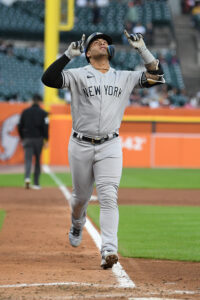Hyun Jin Ryu isn’t ready to say goodbye to Major League Baseball. Speaking with Jeeho Yoo of Yonhap News, the 36-year-old pitcher didn’t offer much insight about his impending free agency, saying, “I don’t know what to tell you at this point. I think we’ll have to wait and see. Only time will tell.” However, while his comments weren’t very revealing, they make it sound like he isn’t planning to retire, at least without testing the waters of free agency first.
To that end, Ryu reconfirmed that when he is ready to leave MLB, he will return to the KBO to finish his career with the Hanwha Eagles. He played for the Eagles from ages 19 to 25. “I haven’t changed my mind on that,” he said. “I will absolutely make that happen.” Once again, his response implies that retirement isn’t on his mind quite yet.
Ryu signed a four-year, $80MM contract with the Blue Jays ahead of the 2020 season. The southpaw excelled during the first year of the deal, pitching to a 2.69 ERA and finishing third in voting for the AL Cy Young. He was solid but hardly ace-like the following season, posting a 4.37 ERA in 31 starts. Unfortunately, his next two campaigns were marred by injury. Ryu needed Tommy John surgery last summer, and he made just 17 starts from 2022-23. He was serviceable upon his return, rejoining the Blue Jays rotation for August and September, but his underlying numbers were worrisome (17% strikeout rate, 4.70 SIERA), and he failed to make the roster for the AL Wild Card Series.
Ryu will be 37 next season, but given his long track record of success and his dominant run from 2018-20, he should draw some interest this winter. If he doesn’t receive any offers to his liking, perhaps he’ll consider heading back to the KBO, but at least for now, it seems like he’s planning to pitch another MLB season in 2024.
In other news from the AL East…
- Tyler Wells lost his job in the Orioles’ rotation this summer. He was optioned just ahead of the trade deadline, and he transitioned to a relief role at Triple-A. About eight weeks later, the towering right-hander earned a call-up back to the big leagues, where he made four scoreless appearances out of the Orioles’ bullpen. He made three more scoreless appearances in the playoffs, taking the mound in all three of Baltimore’s ALDS games. Yet in spite of his success out of the ’pen, the Orioles are expecting Wells to rejoin the starting rotation in 2024, according to Rich Dubroff of BaltimoreBaseball.com. In 20 starts last year, the 29-year-old pitched to a 3.98 ERA and a 4.28 SIERA. However, he looked much stronger over the first three months of the season before he ran out of gas in July. With another year of big league experience under his belt, the Orioles will hope he can stick around for a full season in the rotation.
- In the latest edition of his Yankees Beat newsletter, Bryan Hoch of MLB.com touched on the team’s surplus of options in the middle infield. He suggests the Yankees could look to trade Gleyber Torres, but the possibility of dealing Oswald Peraza is not up for discussion. Torres is a talented second baseman, but he’s a known quantity at this point, whereas Peraza has untapped potential at the plate and in the field. What’s more, the Yankees only have one year of team control remaining over Torres, while Peraza won’t even be eligible for arbitration for at least three more seasons.
